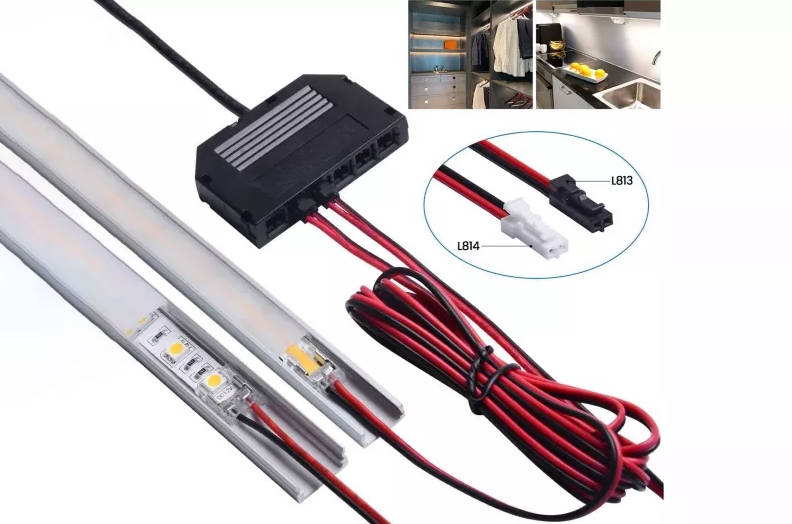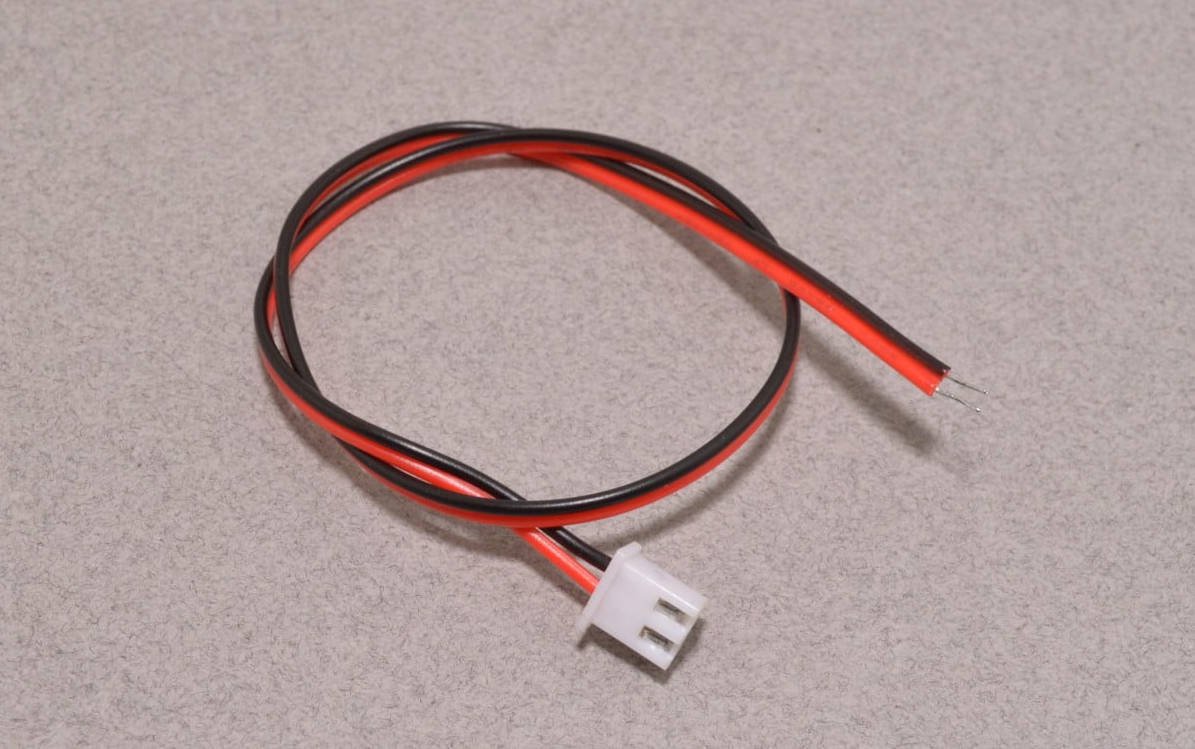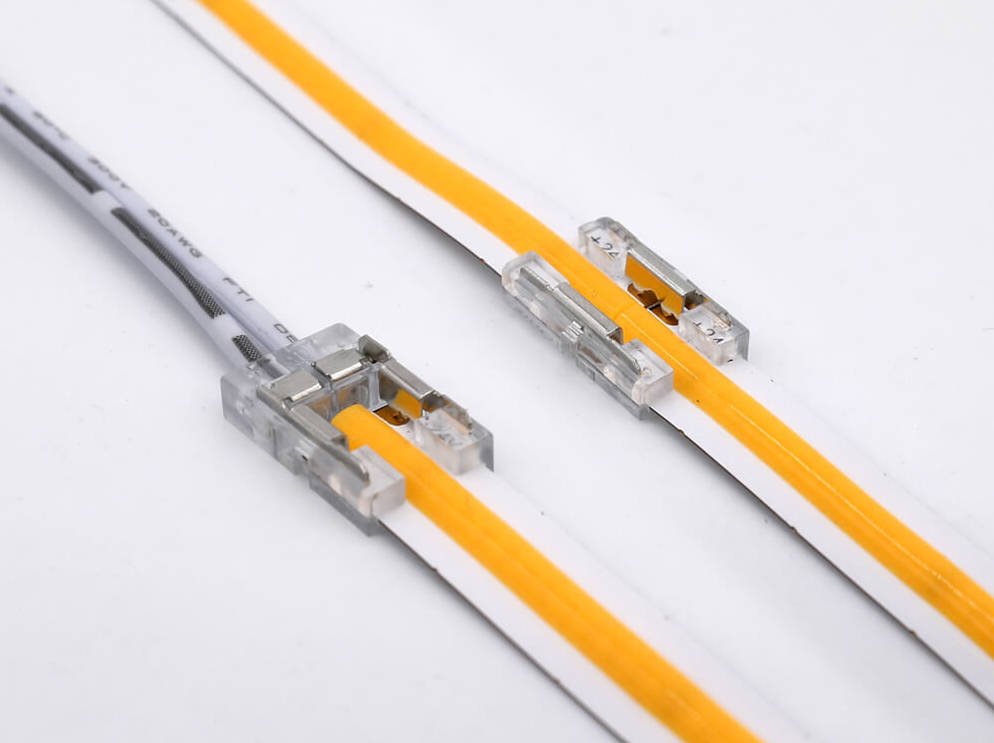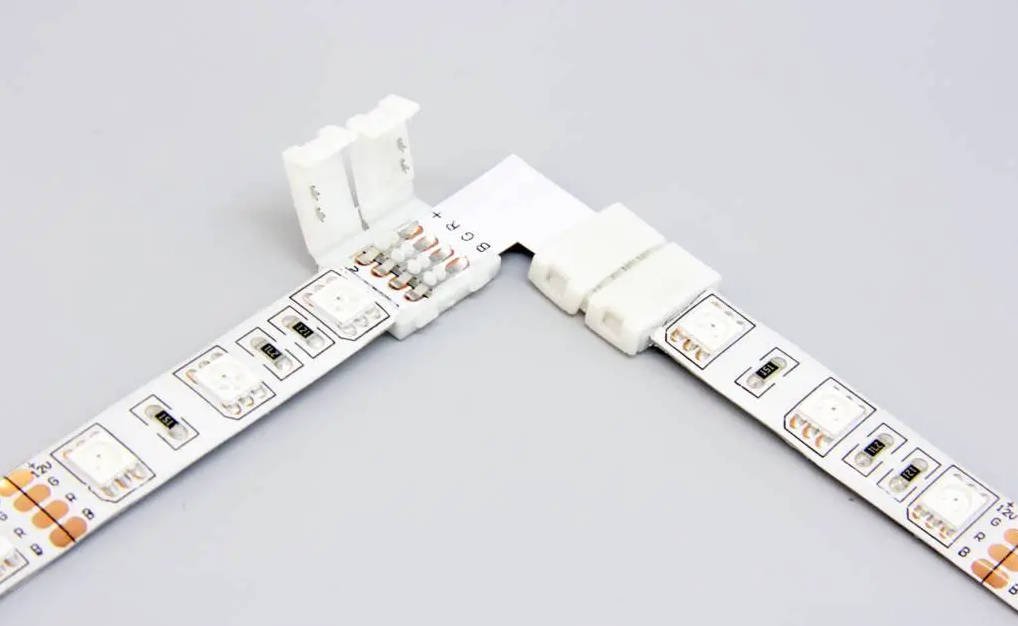Introduction
When setting up an LED lighting project, whether it’s for a DIY home renovation or a professional installation, choosing the right LED Strip Connectors is essential. These connectors are responsible for linking your LED strips to power sources or connecting different strips together, ensuring that your lighting setup works seamlessly.
Among the many connector options available, Clip-On and Push-In connectors are two of the most popular choices. But how do you decide which one is the right fit for your project? In this article, we will explore the differences between Clip-On and Push-In LED strip connectors, their advantages and disadvantages, and the key factors to consider when making your decision. By the end, you’ll have the knowledge you need to select the best connector for your specific needs.

Overview of LED Strip Connectors
Before diving into the specifics of Clip-On and Push-In connectors, let’s briefly review what LED Strip Connectors are and why they are crucial for your installation.
LED Strip Connectors are devices that allow you to connect strips of LED lights to a power supply, other strips, or various components in your lighting system. These connectors ensure that the electrical current flows properly between the strips and the power source. Without a reliable connector, your LED lights won’t work correctly, or the connection may break, causing potential hazards.
When purchasing LED Strip Connectors, it’s important to consider factors such as ease of installation, durability, and the type of LED strip you are using. A trusted LED Strip Connectors supplier can guide you in choosing the correct connectors for your specific project, ensuring optimal performance.
What Are Clip-On LED Strip Connectors?
How Clip-On LED Strip Connectors Work
Clip-On LED strip connectors are designed to create a secure electrical connection by using a mechanical clipping mechanism. These connectors feature small clips that securely attach to the terminals of an LED strip, making contact with the electrical pads to complete the circuit. Often, they require no soldering, making them an easy and convenient option for those who are not familiar with complex electrical work.
Advantages of Clip-On LED Strip Connectors
Ease of Use: One of the primary reasons people choose Clip-On connectors is their simplicity. These connectors are easy to install, and no special tools are required—just press the clips into place. This makes them an excellent option for DIY projects or first-time installers.
Durability: Clip-On connectors are known for their robust mechanical design. They provide a stable connection that can withstand mild vibrations or movement without losing contact. For applications where the installation is not likely to be moved or altered frequently, Clip-On connectors can be a great solution.
Reusability: Another key advantage of Clip-On connectors is their reusability. Unlike other connectors that may require soldering or permanent installation, Clip-On connectors can be easily removed and reused without damaging the LED strip or the connector itself. This feature makes them a versatile choice for temporary installations or projects that may need adjustments over time.
Disadvantages of Clip-On LED Strip Connectors
While Clip-On connectors offer many benefits, there are also some drawbacks to consider.
Size and Aesthetics: Clip-On connectors tend to be bulkier than their Push-In counterparts. If you’re working on a project where space is limited or you want a sleek, minimalistic look, Clip-On connectors might not be the best fit.
Less Secure Contact in Certain Applications: While Clip-On connectors are reliable for low to medium power applications, they may not be as secure in high-power situations. In such cases, the mechanical connection may be less stable, which can lead to electrical issues or reduced performance.
What Are Push-In LED Strip Connectors?
How Push-In LED Strip Connectors Work
Push-In connectors operate with a spring-loaded mechanism that automatically holds the LED strip in place once inserted. With this design, the user simply inserts the LED strip into the connector, and the spring-loaded contacts create a secure electrical connection. This is a tool-free process that is quick and efficient, making Push-In connectors another popular choice for both professionals and DIY enthusiasts.
Advantages of Push-In LED Strip Connectors
Compact Design: One of the standout features of Push-In connectors is their compact size. These connectors take up less space, making them ideal for installations where space is at a premium or where you want a more aesthetically pleasing, discreet look.
Secure and Reliable Connection: Push-In connectors are typically more reliable than Clip-On connectors, especially in high-power applications. The spring mechanism provides a strong electrical contact, which ensures that the LED strip maintains consistent power flow. This makes Push-In connectors an excellent option for professional installations or long-term projects.
Ease of Installation: Like Clip-On connectors, Push-In connectors are easy to install, with no soldering required. Simply push the LED strip into the connector, and the spring-loaded mechanism does the rest. This makes them suitable for a wide range of users, from amateurs to experienced installers.
Disadvantages of Push-In LED Strip Connectors
While Push-In connectors have their advantages, they are not without drawbacks.
Difficult to Disconnect: Unlike Clip-On connectors, which can be easily removed and reused, Push-In connectors may be more difficult to disconnect without causing damage to the connector or LED strip. This can be problematic if you need to reconfigure your lighting setup or make adjustments.
Limited to Specific Wire Sizes: Push-In connectors are often designed to accommodate specific wire gauges. If your LED strips have different wire sizes, you may find that the Push-In connector doesn’t fit, making it necessary to choose a different connector type or find a connector with adjustable settings.
Key Factors to Consider When Choosing Between Clip-On and Push-In Connectors
Choosing the right LED Strip Connectors for your project involves several considerations, beyond just the basic design of Clip-On and Push-In connectors. Here are the key factors to take into account when making your decision:
1. Project Type and Complexity
The complexity of your project is an important factor in selecting the appropriate connector. If you’re working on a DIY project or need a simple, temporary connection, Clip-On LED Strip Connectors might be the best choice due to their ease of installation and reusability.
On the other hand, if your project involves more complex, permanent installations (such as lighting for businesses or high-end architectural features), Push-In connectors offer a more reliable, secure connection that is ideal for long-term use. They are commonly used in commercial and industrial settings where reliability is critical.
2. Aesthetic Considerations
If aesthetics are important to you, the size and appearance of the connector may play a significant role in your decision. Push-In connectors tend to be smaller and more discreet, making them an excellent choice for projects where visual appearance matters. Their compact design allows for a cleaner, more polished look, especially when installed in tight spaces.
Clip-On connectors, while functional, are generally bulkier and may not blend seamlessly into your design, especially for visible installations. If you’re looking to hide the connectors or ensure that they don’t stand out, Push-In connectors could be the better option.
3. Installation Environment
The environment where you’re installing your LED strip lights can also affect your choice of connector. For example, if the installation is subject to vibrations or movement, Clip-On connectors might provide a more secure connection because of their mechanical clamping design. This makes them a good choice for environments like vehicles or areas where the lights might be exposed to slight shifts or bumps.
For environments that require a more stable and secure connection, such as in permanent, high-power applications, Push-In LED Strip Connectors are often preferred. They provide a stronger electrical connection that can withstand long-term use without the risk of becoming loose or disengaged.
4. Power Requirements
Consider the power requirements of your LED strips. If you’re working with high-power LED strips, Push-In connectors are typically a better choice due to their strong electrical contact. The spring-loaded mechanism in Push-In connectors ensures a reliable and consistent connection, even with high-current demands. This makes them ideal for large-scale projects or professional lighting installations.
For lower-power LED strips or smaller DIY projects, Clip-On connectors can be sufficient, providing the flexibility and ease of installation needed without compromising performance. However, if you foresee the need for future upgrades or changes to the lighting system, a more durable and secure Push-In connector might be a wise choice.
5. Ease of Use
Both Clip-On and Push-In LED Strip Connectors are designed for easy installation, requiring no soldering or complex tools. However, the level of ease may depend on the specific needs of your project.
Clip-On connectors are typically simpler to handle, especially for beginners. Their mechanical design means that once you clip them into place, they’re secure and ready to use. For users who need to frequently change configurations or are working with different strip types, Clip-On connectors may be a convenient, tool-free option.
Push-In connectors may require a bit more care when inserting the LED strip, especially if the strip is not perfectly aligned. However, they are equally easy to install and can provide a more stable connection once set up. For installations where reconfiguration is less frequent, Push-In connectors may offer a more reliable long-term solution.
Common Applications for Each Type of Connector
Clip-On LED Strip Connectors
Clip-On connectors are often used in smaller-scale, DIY projects or applications where frequent adjustments or flexibility is needed. Here are some examples of where you might use Clip-On connectors:
- Home and office lighting: For accent lighting, under-cabinet lights, or small-scale installations that don’t require high power.
- Temporary setups: If you’re creating a temporary lighting design for an event or a trade show.
- Custom installations: In creative DIY projects where you want the ability to adjust or change the LED strips without damaging the connectors.
Push-In LED Strip Connectors
Push-In connectors are typically used in larger, more permanent installations, and they are ideal for commercial or industrial settings. Some common applications include:
- Professional lighting installations: Large-scale or high-power lighting projects that require a secure, long-term connection.
- Outdoor and architectural lighting: For installations exposed to the elements, where a reliable, weatherproof connector is needed.
- High-current or high-power applications: Where consistent and stable electrical contact is crucial, such as in stadiums, shopping malls, or street lighting systems.
How to Properly Install and Maintain LED Strip Connectors
Installing Clip-On LED Strip Connectors
- Prepare the LED Strip: Ensure the LED strip is cut to the correct length and that the solder pads are clean and free of any obstructions.
- Align the Connector: Place the Clip-On connector over the strip, making sure that the clip aligns with the LED strip’s solder pads.
- Secure the Connector: Gently press the connector into place, ensuring it locks onto the strip. Double-check the connection to ensure it’s secure.
Installing Push-In LED Strip Connectors
- Prepare the LED Strip: Clean the strip’s solder pads and trim the strip to the appropriate length.
- Insert the Strip: Insert the LED strip into the Push-In connector, ensuring the contacts align with the solder pads.
- Push to Secure: Push the strip fully into the connector until it clicks into place. Check for a firm connection by gently pulling on the strip.
Maintenance Tips
- Regularly inspect the connectors for signs of wear, corrosion, or damage.
- Keep the LED strips and connectors free from dirt and moisture, especially in outdoor installations.
- For Push-In connectors, ensure that the connector is not being over-stressed or bent too much, as this could weaken the connection over time.
Conclusion
When deciding between Clip-On and Push-In LED Strip Connectors, it’s essential to consider the specific needs of your project. If you’re looking for a simple, reusable option for small or temporary installations, Clip-On connectors might be the best choice. However, if you need a more reliable, secure connection for larger, high-power, or permanent installations, Push-In connectors offer enhanced durability and performance.
Choosing the right LED Strip Connectors manufacturer or LED Strip Connectors supplier can further ensure that you’re getting high-quality connectors designed to meet your specific needs. Whether you’re a DIY enthusiast or a professional lighting installer, understanding the differences between these two types of connectors will help you achieve the best possible lighting solution for your project.



